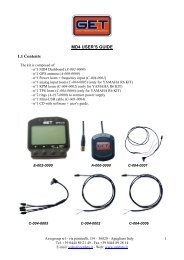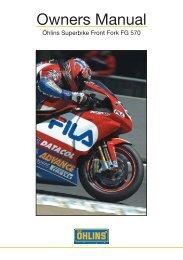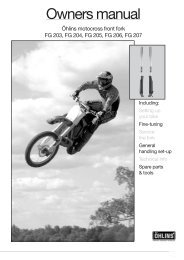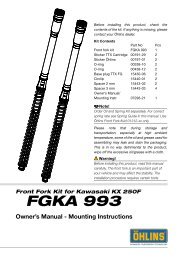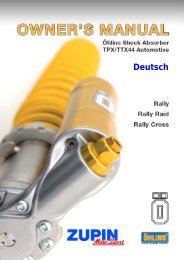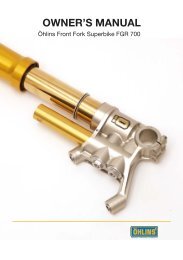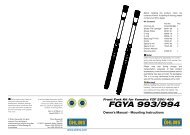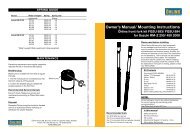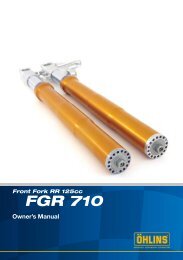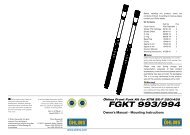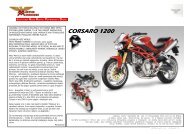Cane Creek Double Barrel Instructions - Zupin
Cane Creek Double Barrel Instructions - Zupin
Cane Creek Double Barrel Instructions - Zupin
Create successful ePaper yourself
Turn your PDF publications into a flip-book with our unique Google optimized e-Paper software.
<strong>Cane</strong> <strong>Creek</strong> <strong>Double</strong> <strong>Barrel</strong> <strong>Instructions</strong><br />
Congratulations on your purchase of<br />
the <strong>Cane</strong> <strong>Creek</strong> <strong>Double</strong> <strong>Barrel</strong> rear<br />
shock. Developed in partnership<br />
with Öhlins Racing, the <strong>Double</strong><br />
<strong>Barrel</strong> brings revolutionary suspension technology to the bicycle market. For<br />
nearly three decades, Öhlins Racing AB, based in Stockholm, Sweden, has<br />
produced high-performance suspension systems for the elite teams in all<br />
disciplines of World Class motor sport racing. Sharing the precision quality and<br />
exceptional performance that is inherent in Öhlins’ designs, the <strong>Double</strong> <strong>Barrel</strong> is<br />
designed for performance in extreme off road conditions. The unique Twin Tube<br />
design incorporated in the DB-1 offers the broadest adjustment range available in<br />
suspension. The DB-1’s adjustment features give you the control to tune the<br />
shock your way for your bike. Enjoy the ride.<br />
Caution: Reading and following the set-up instructions carefully and<br />
methodically is critical. Incorrect tuning can produce poor results or even<br />
dangerous riding performance. See pages 5 & 6 for key set-up<br />
instructions.<br />
Design Background:<br />
Most shock absorbers are the De Carbon type (figure 1). These shocks separate<br />
the gas from the oil with a dividing piston, usually located in a remote (or piggy<br />
back) reservoir. Primary<br />
damping takes place via the<br />
main piston by using a shim<br />
stack. The shim stack<br />
resists the flow of oil though<br />
the ports on the piston.<br />
Stiffer shims yield more<br />
resistance; and, thus, more<br />
damping force. Some oil is<br />
also displaced by the shaft<br />
entering the body chamber.<br />
This oil flows out to the<br />
reservoir where the<br />
expansion chamber can<br />
accommodate it. When the<br />
shock rebounds, this oil<br />
returns to the main chamber<br />
by the same route.<br />
Variations of this style of<br />
shock will incorporate<br />
external adjusters to control<br />
the damping characteristics.<br />
The most common<br />
adjustment controls the<br />
rebound damping. A small<br />
needle valve running<br />
Figure 1: De Carbon type<br />
through the center of the<br />
piston shaft controls the<br />
flow of oil as the shock Figure 2: Twin Tube type<br />
10/14/09 Page 1 of 7
Figure 3: Low speed bleed valve.<br />
Figure 6: Shock dynamometer<br />
Figure 4: High speed poppet valve.<br />
extends. In some designs adjusters are added to the reservoir passage as<br />
well.<br />
The De Carbon style shocks function very well if adjusted properly.<br />
Unfortunately, the external<br />
adjusters are limited in their<br />
range. The rebound bleed valve Figure 5: Main piston shim stack.<br />
works primarily on low speed<br />
damping. Thus, it has little effect on high speed movement. Also,<br />
external adjusters on the reservoir have little effect. The reason is<br />
that they dampen only a small percentage of the oil—only the oil<br />
displaced by the piston shaft. Some designs will try to increase the<br />
effect by using larger piston shafts, but this has a negative effect on<br />
the pressure balance and performance of the shock overall. So, to<br />
achieve the best characteristics, the shock must be disassembled<br />
and re-valved for each specific application—not an easy task.<br />
The Twin Tube technology (figure 2) incorporated in the <strong>Double</strong><br />
<strong>Barrel</strong> shock is different. Rather than pumping only displaced oil<br />
back and forth to the reservoir, the oil circulates continuously through<br />
the valving to achieve highly controllable, independent damping.<br />
There are three distinct damping features in the DB-1 for both the<br />
compression and rebound strokes. The low speed adjusters (figure<br />
3) consist of needle style bleed valves that control the flow of oil<br />
when the shaft is moving slowly. Turning the slotted screw varies the<br />
size of the orifice through which the oil flows. A larger orifice allows<br />
more oil flow and, thus, more suspension movement for slow speed<br />
travel. The high speed adjusters are poppet style valves (figure 4)<br />
that open once the pressure from the oil flow is significant enough.<br />
Turning the hex adjusters varies the spring preload behind the<br />
poppet and determines the opening force. Finally, the main piston in<br />
the shock has both a compression and rebound shim stack (figure 5).<br />
These control the high speed damping characteristics for general<br />
10/14/09 Page 2 of 7
suspension control. Separating all these components are check valves that allow them to operate totally<br />
independently.<br />
The value of the <strong>Double</strong> <strong>Barrel</strong> design is in the external adjustments enabled by the twin tube technology.<br />
Rather than disassembling the shock to change shim stacks, an equivalent range of control can be achieved by<br />
simply turning the adjusters. Changing the adjustment of one will not affect the performance of another. You<br />
have immediate feedback on the trail. All these features work together to create the perfect performance for<br />
your unique riding style and conditions.<br />
Theory:<br />
In order to better understand the<br />
function of the <strong>Double</strong> <strong>Barrel</strong> shock,<br />
it is helpful to have some<br />
background in the science behind<br />
dampers. Dampers are basically<br />
energy absorbers. They accomplish<br />
this by slowing the flow of oil though<br />
various types of valves. Because oil<br />
is nearly incompressible, it is a good<br />
fluid for precise damping control.<br />
The more the oil is constricted, the<br />
more the motion of the shock is<br />
slowed. The energy from the bump<br />
on the trail is transformed into heat<br />
in the oil through the damping<br />
process.<br />
Force<br />
nose<br />
knee<br />
Velocity<br />
When discussing damper dynamics<br />
Figure 7: Damping curve from a dynamometer<br />
the terms “low speed” and “high<br />
speed” are discussed. This does not refer to the velocity of the bike, but rather, the speed of movement of the<br />
shock’s piston shaft into the body of the shock. Low speed inputs come from slow undulations on the trail or<br />
movement of the frame caused by pedaling forces. High speed inputs are a result of bigger impacts such as<br />
dropping off a ledge or hitting a bump rapidly.<br />
In order to determine the characteristics of a particular shock the damper forces must be measured. A<br />
dynamometer is a test device used to study this performance. The damper is cycled though a compression and<br />
rebound stroke while measuring the force it produces. This information if graphed on a force vs. velocity plot. A<br />
typical dynamometer curve would show that as the<br />
velocity of the shaft increases the force also increases.<br />
The three regions of the typical damping curve are the<br />
nose, knee, and slope (figure 7). The nose is the low<br />
speed (slow shaft movement) region and the slope is<br />
the high speed region. The knee is the transition<br />
between the two. The adjustments made to the shock<br />
will affect the force output at the various shaft<br />
velocities.<br />
The low speed adjustment will affect the force in the<br />
nose region of the graph as shown in figure 8. More<br />
low speed damping will increase the amount of force<br />
generated for a given velocity. On the trail, this means<br />
that the slow shaft movement generated by small<br />
inputs like pedaling forces will be controlled.<br />
10/14/09 Page 3 of 7<br />
Force<br />
slope<br />
Increasing low speed damping<br />
Velocity<br />
Figure 8: Effect of low speed damping adjustment.
The high speed adjustment controls the damper<br />
force in the slope portion of the curve (figure 9). The<br />
slope of the curve increases with more damping<br />
input. Thus, more force is generated at a given shaft<br />
velocity. On the trail, this translates into the damper<br />
being able to absorb bigger hits without bottoming<br />
out.<br />
Function:<br />
The <strong>Double</strong> <strong>Barrel</strong> design enables the independent<br />
control of each portion of the damping curve for both<br />
compression and rebound strokes. The unique<br />
valving has a significant effect due to the fact it is<br />
continuously acting on the oil pumped through the<br />
circulating system.<br />
Force<br />
Velocity<br />
Increasing high<br />
speed damping<br />
Figure 9: Effect of high speed damping adjustment.<br />
For low speed shaft movement, the brass needle valves control the shock’s response. The movement of the<br />
piston does not produce enough pressure to open the main shim stack or poppet valves. Therefore, the oil is<br />
directed through the precisely metered needle valve orifice (figure 10 & 11). This restricted flow damps the<br />
movement of the shaft minimizing the undesired suspension movement. The low speed damping adjustability<br />
for both the compression and rebound strokes allows the rider to fine tune the performance to the rider’s style.<br />
If the shock movement comes primarily from powerful pedal strokes, then increasing the low speed compression<br />
damping will dial this out. If the movement seems linked more to the “dead” spots in the pedal stroke, then the<br />
low speed rebound adjustment can effectively reduce shock movement and suspension “bob”. Be careful in<br />
using the rebound damping adjustment as too much damping may cause the shock to “pack up” and not be<br />
ready to respond to successive hits.<br />
For high speed shaft movement, when the wheel hits a significant obstacle, the high speed damping takes over.<br />
This high speed damping is controlled using two components: the main piston shim stack and the high speed<br />
adjustment poppet valves. During an impact, the oil pressure builds up in front of the piston as the low speed<br />
Oil flows through<br />
the low speed<br />
bleed valve.<br />
Figure 10: Low speed compression flow<br />
Oil flows through low<br />
speed bleed valve.<br />
Figure 11: Low speed rebound flow<br />
10/14/09 Page 4 of 7
passages are too small to handle the flow. The oil pushes open the poppet valve and piston shim stack allowing<br />
the suspension to move while absorbing the energy from the impact. The order in which these two high speed<br />
valves open depends on the settings. The piston shim stack is fairly stiff and will typically open later than the<br />
softer, high speed poppet valve. If the poppet damping is increased it may open slightly later than the main<br />
shim stack. Either way, this dual path valving enables the greatest control of damping characteristics for the<br />
high speed range for both compression and rebound strokes. You can see the high speed oil flow paths in<br />
figures 12 & 13.<br />
Mounting the DB-1:<br />
When mounting the shock on the frame check carefully to make sure the shock does not contact the frame at<br />
any point in the travel. The shock and suspension must move freely without restriction.<br />
mounting spacer (2x)<br />
o-ring (2x)<br />
Compression<br />
poppet opens<br />
(high speed)<br />
Piston compression<br />
shim stack opens<br />
Figure 12: High speed compression flow<br />
alignment<br />
pin<br />
Piston rebound shim<br />
stack opens<br />
Rebound<br />
poppet opens<br />
(high speed)<br />
Figure 13: High speed rebound flow<br />
1. Assemble spacers 2. Insert in frame 3. Push pin out while inserting bolt<br />
8mm bolt<br />
10/14/09 Page 5 of 7
Setup and Adjustments:<br />
The first thing you will notice when getting on your bike will be how soft the suspension feels. Don’t worry, that<br />
is how it is supposed to feel. Suspension is intended to move easily with as little friction as possible. The<br />
damping controls of the <strong>Double</strong> <strong>Barrel</strong> can handle the big hits even though it feels very soft in the parking lot.<br />
Try it and see.<br />
When starting out on the <strong>Double</strong> <strong>Barrel</strong> for the first time, use the recommended adjustment settings listed below.<br />
Find a familiar section of trail you can ride repeatedly as you make incremental adjustments to the shock. Never<br />
make more than one adjustment at a time and only use small increments. The adjusters on the <strong>Double</strong> <strong>Barrel</strong><br />
are very sensitive. Even small steps can have a big effect.<br />
Tuning order:<br />
1. Make the necessary spring adjustments to achieve the proper sag setting for your shock.<br />
2. Adjust the High Speed Rebound Damping<br />
3. Adjust the High Speed Compression Damping<br />
4. Adjust the Low Speed Damping settings<br />
Recommended Start Settings:<br />
Compression<br />
Rebound<br />
Spring<br />
Preload<br />
Adjuster Setting Reference<br />
High Speed (hex) Two (2) turns in from fully<br />
open<br />
Low Speed (screw) Eight (8) clicks out from<br />
fully closed<br />
High Speed (hex) Two (2) turns in from fully<br />
open<br />
Low Speed (screw) Twelve (12) clicks out from<br />
fully closed<br />
Spring Adjustment<br />
Nut<br />
Based on measurements<br />
described below<br />
Open is fully counterclockwise<br />
(all the way out)<br />
Closed is fully clockwise (all<br />
the way in)<br />
Open is fully counterclockwise<br />
(all the way out)<br />
Closed is fully clockwise (all<br />
the way in)<br />
Zero preload is just enough<br />
to secure the spring<br />
Inspection and Maintenance:<br />
The DB-1 shock is designed for durability, though, some simple maintenance steps can insure long life and<br />
smooth function.<br />
1. Use compressed air to blow away all debris.<br />
2. The shock can be cleaned with a mild detergent.<br />
3. Recommended periodic maintenance is every 100 hours of use. This involves checking the reservoir<br />
pressure, inspecting seals, inspecting bushings and possibly changing the damper oil. This inspection<br />
should only be performed by a certified <strong>Cane</strong> <strong>Creek</strong> technician. Call a <strong>Cane</strong> <strong>Creek</strong> technical service at<br />
800-234-2725.<br />
Caution: Do not attempt to disassemble or refill the gas or oil in the shock. Doing so could be dangerous and will void the<br />
warranty. Please call a <strong>Cane</strong> <strong>Creek</strong> technical service representative. 800-234-2725<br />
10/14/09 Page 6 of 7
<strong>Double</strong> <strong>Barrel</strong> Tuning Tips…<br />
Spring &<br />
Spring<br />
Preload<br />
High Speed<br />
Rebound<br />
Damping<br />
pewter hex<br />
adjuster<br />
High Speed<br />
Compression<br />
Damping<br />
copper hex<br />
adjuster<br />
Low Speed<br />
Compression<br />
Damping<br />
brass screw<br />
inside<br />
copper hex<br />
adjuster<br />
Low Speed<br />
Rebound<br />
Damping<br />
brass screw<br />
inside pewter<br />
hex adjuster<br />
What it does… What you should know… How to set it…<br />
The spring stores and releases the<br />
energy to rebound the suspension to<br />
position following a hit.<br />
Controls the extension of the shock<br />
following a big hit. Rebound<br />
damping resists the force of the<br />
spring as it expands the shock.<br />
Controls the compression of the<br />
shock for big hits that move the<br />
shock’s shaft at high velocity.<br />
Compression damping assists the<br />
spring in absorbing the initial impact<br />
of a hit<br />
Controls the compression of the<br />
shock in the pedal stroke and on<br />
small, slow bumps.<br />
Controls frame movement of the<br />
bike as a result of pedaling.<br />
Controls the response to small,<br />
repeated bumps.<br />
Various spring rates are available<br />
based on your weight, the frame<br />
design and leverage ratio. The DB-1<br />
is available with either steel or<br />
Titanium springs. A stiffer spring (high<br />
spring rate) supports a heavier rider.<br />
The spring preload can adjust the sag<br />
in the suspension. Turning the<br />
Adjuster Nut can add or reduce the<br />
spring preload. One turn of the<br />
adjuster nut equals 1mm of spring<br />
preload.<br />
Affects the response of the shock<br />
when returning from deep in the travel.<br />
Less rebound damping is good<br />
because it enables the wheel to return<br />
to the ground more quickly. Full<br />
adjustment range is 4 revolutions.<br />
Affects the bottoming resistance of the<br />
shock. More compression damping is<br />
good as it keeps the tire against the<br />
ground, thus, increasing control.<br />
Note: You will only sense adjustment<br />
changes on big hits. High speed has<br />
nothing to do with the speed of the<br />
bike. High speed refers to how fast<br />
the shock compresses. Full<br />
adjustment range is 4 revolutions.<br />
Low speed compression and low<br />
speed rebound damping work together<br />
to finely tune the suspension<br />
characteristics to your specific needs.<br />
Low speed compression damping has<br />
the biggest impact on pedal bobbing<br />
as it controls how fast and deep the<br />
bike will sag with each pedal turn. The<br />
low speed rebound controls how fast<br />
the bike comes back up. If you restrict<br />
pedal bobbing completely using just<br />
one adjuster you will loose<br />
performance when not pedaling. It is<br />
best to balance the pedaling isolation<br />
using a combination of the two low<br />
speed adjusters. Full adjustment<br />
range is 24 clicks.<br />
<strong>Cane</strong> <strong>Creek</strong> Cycling<br />
Components<br />
355 <strong>Cane</strong> <strong>Creek</strong> Road<br />
Fletcher, NC 28732<br />
800-234-2725<br />
www.canecreek.com<br />
Measure the shock length with the rear<br />
wheel off the ground. Sit on the bike in<br />
your normal riding position and measure<br />
the length again. The difference<br />
between the two measurements should<br />
be 30% of the shock’s travel. For<br />
example, if your shock has 70mm of<br />
travel, the difference in length should be<br />
21mm (70 x 0.30 = 21mm). If you don’t<br />
have enough sag, reduce the spring<br />
preload until the measurement is correct.<br />
If you have more than 10mm of spring<br />
preload you should use a stiffer<br />
spring.<br />
Increasing the rebound damping will slow<br />
down the return of the shock to its full<br />
length. If the suspension feels too<br />
bouncy or loose, increase the rebound<br />
damping. If the feel is hard and bumpy,<br />
especially over a series of bumps,<br />
decrease the rebound damping. Make<br />
adjustments in ½ turn increments.<br />
Clockwise rotation increases<br />
damping.<br />
Increasing compression damping will<br />
reduce the amount of stroke consumed<br />
in absorbing a hit. If the shock is<br />
bottoming too much, increasing high<br />
speed compression damping will improve<br />
the performance. If the suspension is<br />
too harsh on big hits, reduce the<br />
damping. Make adjustments in ½ turn<br />
increments. Clockwise rotation<br />
increases damping.<br />
Increasing compression damping will<br />
slow the movement of the suspension for<br />
small low velocity inputs (like pedaling).<br />
If you feel the suspension bobbing too<br />
much, increase the low speed damping.<br />
Make adjustments in 2 click<br />
increments. Clockwise rotation<br />
increases damping.<br />
Increasing rebound damping will slow the<br />
return of the shock for low velocity<br />
inputs. If you feel the shock packing up<br />
too much over repeated bumps,<br />
decrease the rebound damping. Make<br />
adjustments in 2 click increments.<br />
Clockwise rotation increases<br />
damping.<br />
10/14/09 Page 7 of 7



